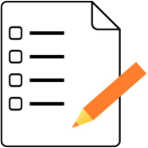Face-to-face: Body language
By far the biggest influencer of how we respond to someone when we meet them is our body language. This includes facial expressions, gestures, posture, proximity, and movement. It’s the best guide to what people really think of us and what we're saying. It's the outward reflection of a person's emotional condition.Here are some body language tips to encourage good face-to-face communication, but be aware that different cultures may have different attitudes to, and styles of, body language:
People’s first impressions are made before you utter a word. Are you dressed appropriately? Do you have your hospital name badge on so that people can check who you are? Do you look friendly or strict?
Maintain eye contact during a conversation because it shows you’re interested. If you look away all the time or (worse) raise your eyes skywards, people will notice, and they don’t like it.
 |
| Smiling helps the other person relax and encourages them to talk |
Smile. This simple friendly gesture puts people at ease and encourages communication. If you smile, people tend to react positively to you. Of course smiling is not appropriate for all communications, such as imparting bad news.
Be careful about personal space. People vary a lot in how close they like someone to be. If you notice someone leaning away or edging back from you, then it’s a sign that you’re too close. Don’t touch other people unless you are sure it will be well-received.
Try not to stand with your hands on your hips: it can look aggressive, irritable, or at least like you’re preparing to leave the conversation.
Avoid folding your arms behind your head and leaning back in a chair: some people interpret this as arrogance.
Leaning forward when sitting is often taken as a sign of enthusiasm, agreement, and being "all set to go". It often happens towards the end of successful conversations.
Slouching in a chair with your legs splayed apart or standing hunched with your hands in your pockets is a bit too casual for work and can give the impression you’d rather be somewhere else.
 Look at the three pictures above. How might you interpret the body language in each case? If you were faced with these stances, what might you do in each situation to try and improve the interaction?
Look at the three pictures above. How might you interpret the body language in each case? If you were faced with these stances, what might you do in each situation to try and improve the interaction?
Although the body language looks negative, might there be other explanations?
When you've had enough time to think, click on the next page to see our thoughts.
Nod your head slowly in agreement to encourage people to say more.
Tilt your head on one side to show that you’re listening and involved.
 |
| Head tilted to one side and looking at you - she's interested in what you are saying |
Open palm gestures suggest honesty and you can use them to encourage interaction.
Try not to cross your arms as it looks negative or insecure. Try holding your hands in your lap if sitting, or behind you if standing.
Be careful about personal space. People vary a lot in how close they like someone to be. If you notice someone leaning away or edging back from you, then it’s a sign that you’re too close. Don’t touch other people unless you are sure it will be well-received.
Try not to stand with your hands on your hips: it can look aggressive, irritable, or at least like you’re preparing to leave the conversation.
Leaning forward when sitting is often taken as a sign of enthusiasm, agreement, and being "all set to go". It often happens towards the end of successful conversations.
Slouching in a chair with your legs splayed apart or standing hunched with your hands in your pockets is a bit too casual for work and can give the impression you’d rather be somewhere else.
Don’t fiddle! Don’t keep checking your watch, playing with pieces of paper, fussing with your clothes, or playing with your mobile: it's distracting and rude.
This brief outline of body language may all seem obvious to you. Alternatively, what we've described might seem like a list of interactive instructions that will make conversations a bit too "acted". However interpreting and using body language is just another professional skill set like decision-making or critical evaluation. It’s up to you to use it to your own advantage.
A helpful book if you'd like to learn more is The Definitive Book of Body Language (Allan & Barbara Pease, Orion, 2017). A key point that the authors make in this book is not to read any single element of body language in isolation, but to read all elements of communication together as a cluster. For example does someone's stance match what they are saying or how they say it?
This brief outline of body language may all seem obvious to you. Alternatively, what we've described might seem like a list of interactive instructions that will make conversations a bit too "acted". However interpreting and using body language is just another professional skill set like decision-making or critical evaluation. It’s up to you to use it to your own advantage.
A helpful book if you'd like to learn more is The Definitive Book of Body Language (Allan & Barbara Pease, Orion, 2017). A key point that the authors make in this book is not to read any single element of body language in isolation, but to read all elements of communication together as a cluster. For example does someone's stance match what they are saying or how they say it?
 |
| Three conversations that are not going well? |
 Look at the three pictures above. How might you interpret the body language in each case? If you were faced with these stances, what might you do in each situation to try and improve the interaction?
Look at the three pictures above. How might you interpret the body language in each case? If you were faced with these stances, what might you do in each situation to try and improve the interaction?Although the body language looks negative, might there be other explanations?
When you've had enough time to think, click on the next page to see our thoughts.
PAGE 2 OF 17. NEXT PAGE ›






